The 12-day, on-campus residential learning workshop, made possible through $300,000 in grant funding from the Scripps Howard Foundation, supported 18 high school rising seniors interested in pursuing careers in journalism and the media industry.

In hindsight, Colin Donohue knows the charge to the students was formidable.
The 18 high school students participating in the inaugural cohort of the Emerging Journalists Program’s Immersion experience were tasked with producing a broadcast news show, a newspaper and a website in just 12 days. It was no small task for the aspiring journalists to manage these responsibilities, as well as a heavily programmed schedule. Yet, they flourished nonetheless, the journalism instructor explained.
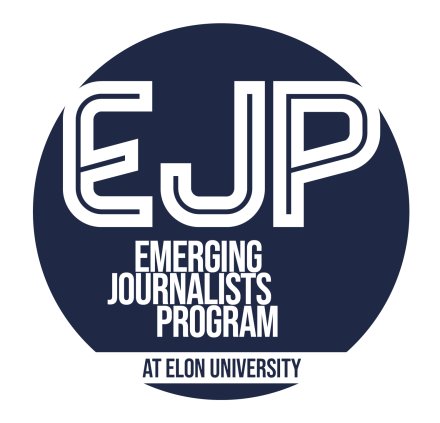 “The students who participated in the Emerging Journalists Program truly exhibited resilience and thoughtfulness,” Donohue said. “That they were able to accomplish all that we asked while continuing to remain upbeat, positive and serious is astounding.”
“The students who participated in the Emerging Journalists Program truly exhibited resilience and thoughtfulness,” Donohue said. “That they were able to accomplish all that we asked while continuing to remain upbeat, positive and serious is astounding.”
This outcome was what Donohue and Kelly Furnas, who co-led the Emerging Journalists Program (EJP), envisioned when the School of Communications secured a three-year, $300,000 grant from the Scripps Howard Foundation to create the journalism initiative. During the late fall and early winter, more than 100 students successfully completed the program’s virtual Exposure experience – a compilation of six online workshops on editing, writing, design and other topics.
Click here to see a robust Flickr album from the Immersion experience.
Then 18 students from across the country were invited to attend the summer Immersion experience, an expenses-paid workshop where students developed and enhanced their skills in reporting, writing, multimedia storytelling, leadership and media management. For their efforts, the students earned one hour of college credit, and individuals who choose to pursue a communications major will receive a scholarship from The LAGRANT Foundation.
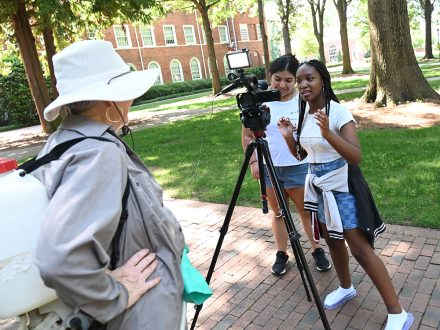
The students’ schedule featured a series of off-campus activities to supplement their classroom, newsroom and studio instruction. There were media tours of G&S Business Communications in Raleigh and WXII 12 News in Winston-Salem, a press conference with Rep. Ricky Hurtado at the North Carolina State Capitol, and a visit to the International Civil Rights Museum in Greensboro. The students even enjoyed – and reported from – a Greensboro Grasshoppers minor league baseball game.
“We created the Emerging Journalists Program to give young people the opportunity to learn how to tell stories across a variety of platforms. And it’s in the practice of journalism that they begin to understand the power they have to impact change and tell the kinds of stories that are often left untold,” Donohue said. “We want the students to return home with a renewed passion for journalism so that they might pursue stories of importance to their local communities and their schools.”
Donohue pointed out that during the students’ two weeks on campus, they were exposed to a variety of storytelling methods. This increased understanding of platforms and media will allow the students to rethink how they present their work to a wider audience, he said.
Collectively, the students had limited-to-no experience with cameras or editing software prior to arriving on campus. Through training sessions and lab time, instructors provided foundational knowledge in broadcast journalism to help the students grow comfortable with the necessary equipment and software. With a better sense of their tools, the students worked on broadcast packages to produce a 40-plus-minute newscast, complete with seven segments on topics ranging from a public schools funding bill to a summer tennis academy. Additionally, Donohue and Furnas worked closely with students to improve their design skills to create a print publication and populate an online news site, www.ejp.news.

The opportunity to learn from college faculty members was a major draw for Michael Messele, a rising senior from Charlotte. As the editor of East Mecklenburg High School’s student paper, he’s already compiled a strong resume, writing about the mismanagement of assault cases in local high schools, as well as producing a documentary on the same topic. He said he came to Elon to build on his past experiences.
“For me, it made sense to get involved with the Emerging Journalists Program because I obviously have an interest in journalism, and it is something I want to study in college,” Messele said. “I figured it was an opportunity to get ahead and be better prepared. Plus, the chance to learn from college professors was something I didn’t want to miss. I’m excited to go back to Charlotte and show my peers and fellow staff members at my high school newspaper how we can enhance our storytelling and the work that we do.”
While currently focused on journalism, Messele said he appreciated the visit to G&S Business Communications, a visit that opened his eyes to how his skills could be utilized in public relations and other communications industries. “There are a multitude of routes that are available to people who can write, report and communicate well – and it was great that Kelly and Colin showed us some of those routes,” he said.
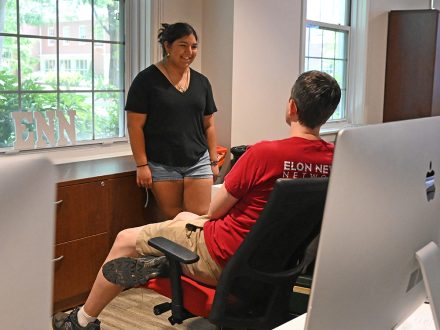
Bella Pelini, a rising senior from Tinley Park, Illinois, commended Donohue, Furnas and their fellow EJP instructors for their patience, understanding and good humor.
“Kelly and Colin were so helpful throughout this experience,” said Pelini, who is interested in broadcast journalism. “They are constructive with their criticism, which I appreciate. They will tell you when something is wrong, and how you can improve it, but they do it in a way that is helpful and easy to accept. You can see that they truly care.”
The student cohort seemed to bond almost immediately once on campus. Messele said he enjoyed hearing stories from his peers, learning from one another’s similar experiences, and finding common ground – of which there was plenty.
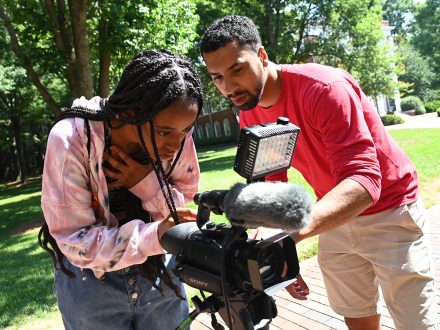
“We are all weirdly similar – in a good way,” Pelini added. “We are from all over, but we have the same humor and same interests. Everyone really gets along. It has been fun to make new friends, see what they take away from this experience, and how we all fit together.”
This component of peer-to-peer education is one of the most exciting aspects of the Immersion experience, according to Furnas.
“We were really deliberate in designing this program that students would be able to share their personal experiences,” he said. “On the last day of the workshop, we went around the table and asked students what they learned from the program. While Colin and I were pleased at the hard skills they learned, we were overjoyed that they all highlighted the confidence and teamwork that they developed during EJP.”
Donohue said the Immersion experience with these smart and passionate students has left him hopeful for the kinds of students entering college and preparing for careers in journalism and communications.
“As an educator, I gain energy when students ask great questions, demonstrate improvement and give their best effort,” he said. “The EJP students checked all those boxes, but they were also good people. I can honestly say it has been one of the most memorable and meaningful experiences of my professional career.”
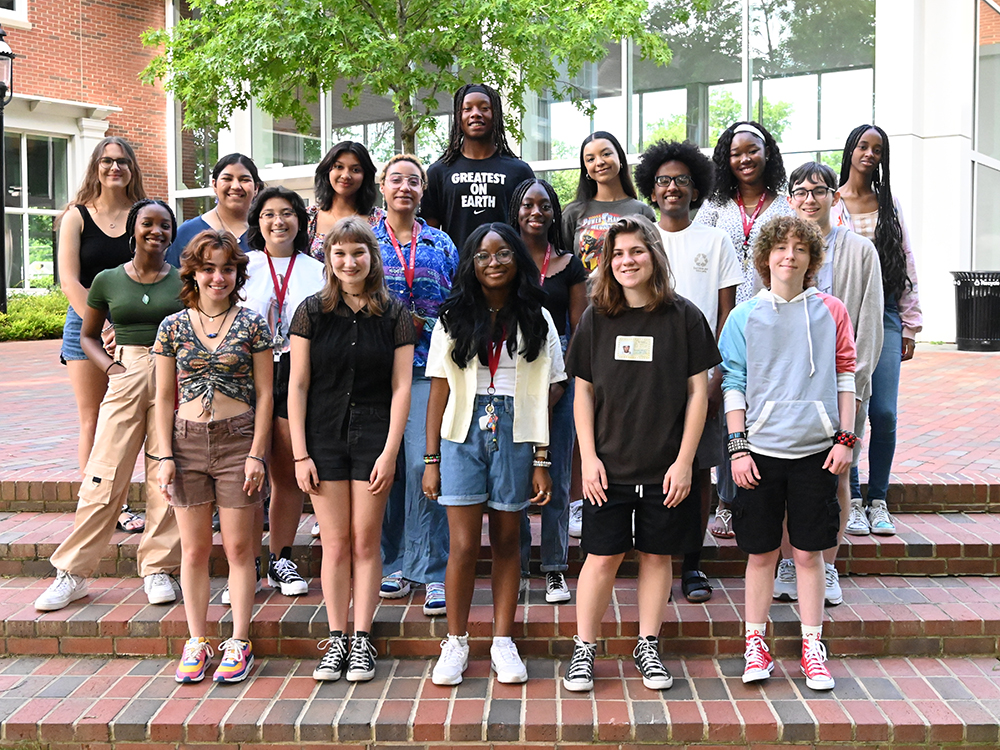
This article also appears in the School of Communications’ 2021-22 annual report.


